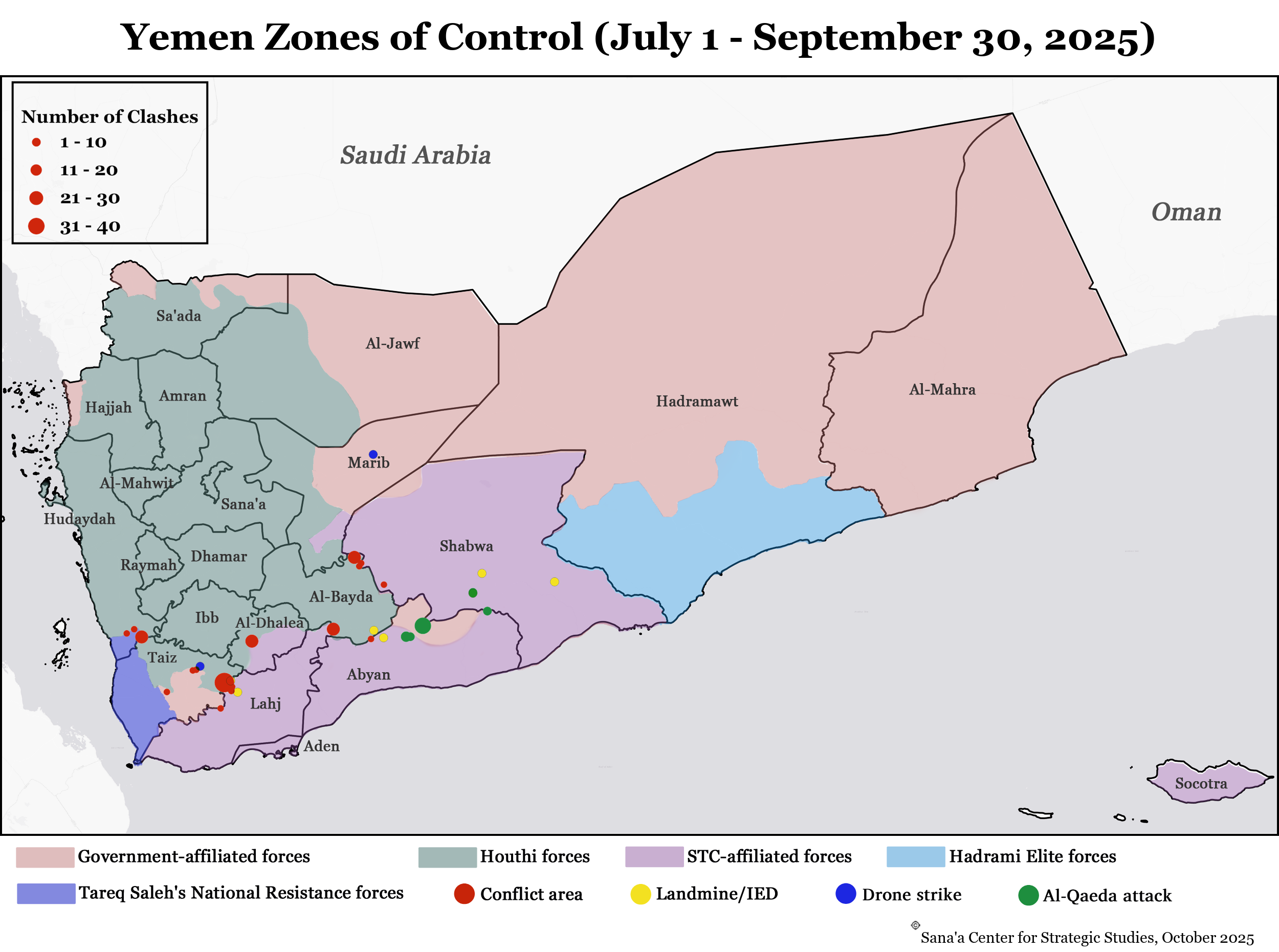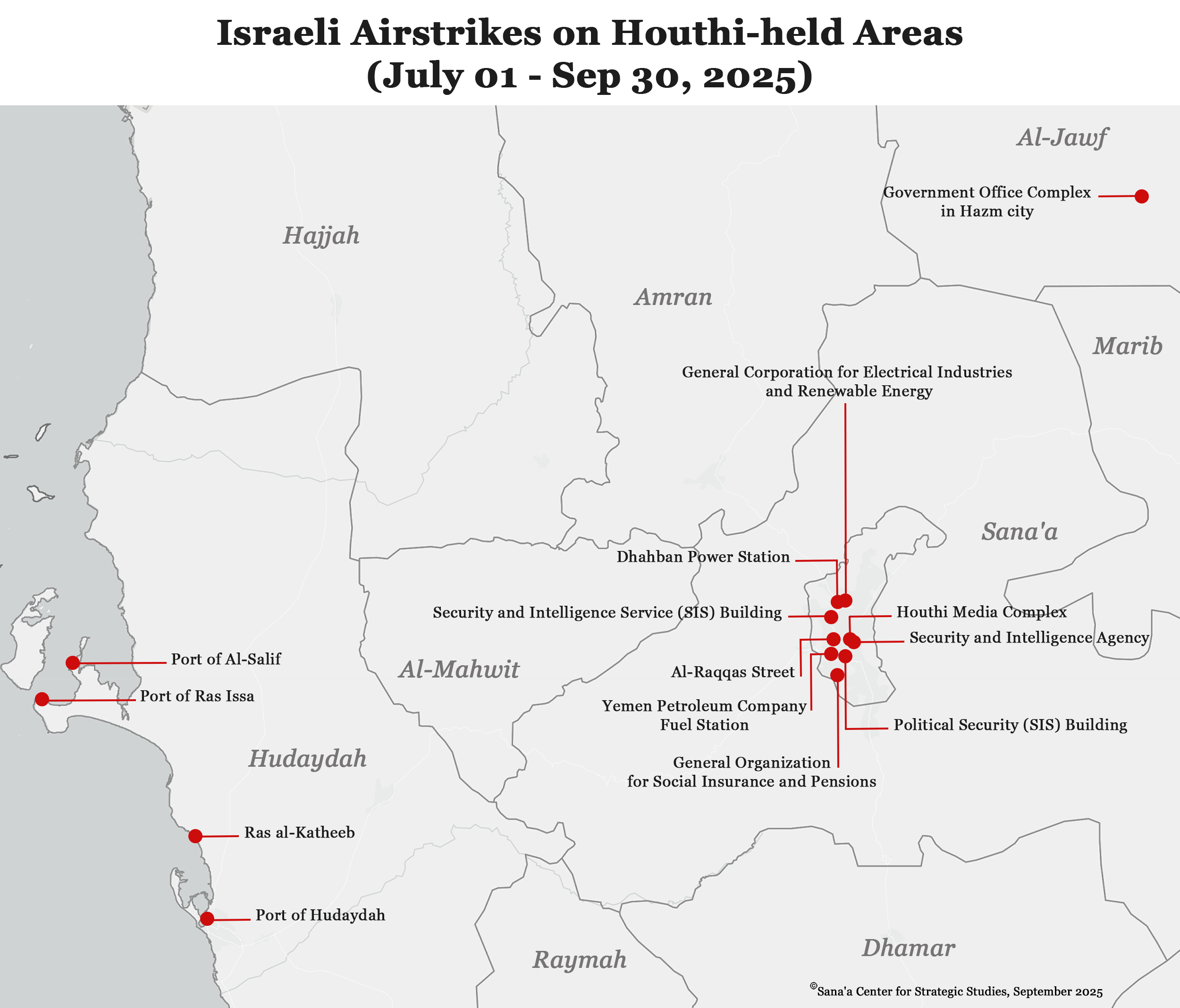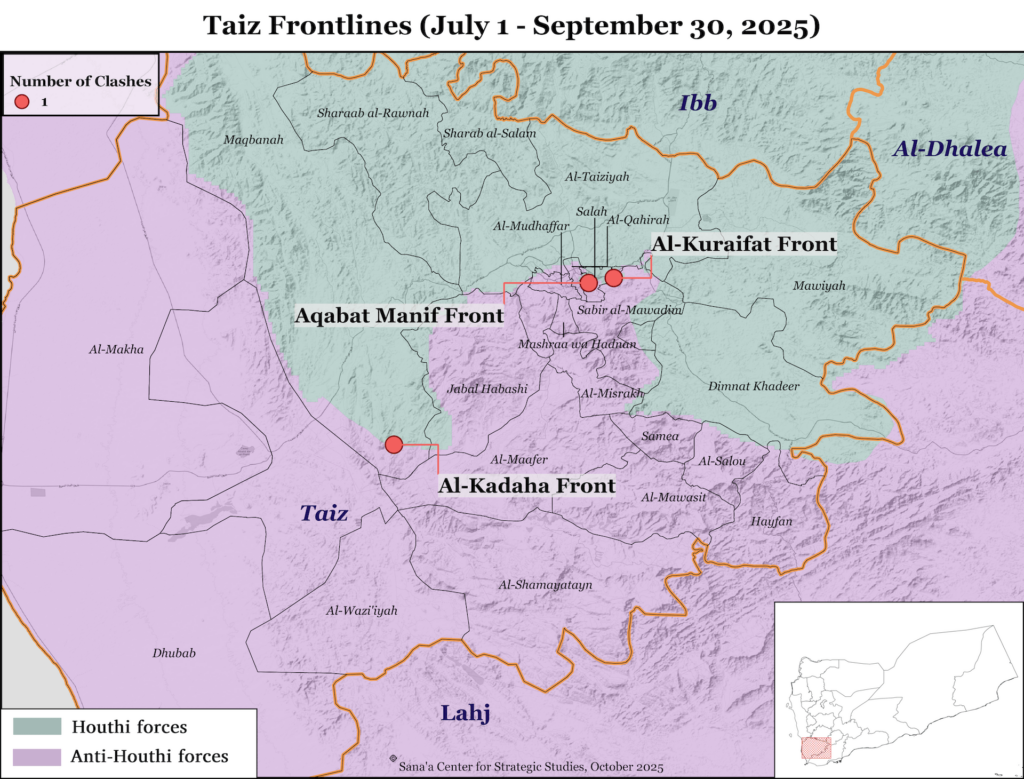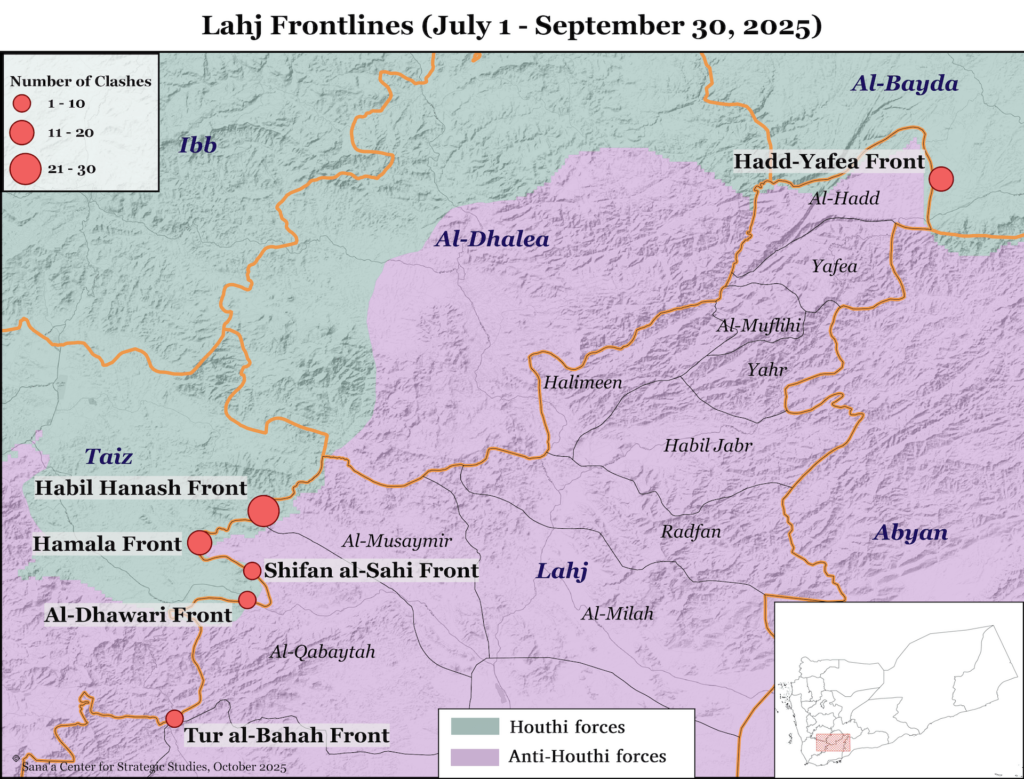The late summer saw an intense escalation in hostilities between Israel and the Houthi group (Ansar Allah). Repeated Houthi drone and missile strikes on Israel brought retaliation in the form of air and missile strikes. Israel targeted Houthi-held ports in Hudaydah, along with military installations, power plants, and dual-use infrastructure. Israel also demonstrated that it possessed the requisite intelligence and willingness to target the authorities in Sana’a – Houthi-appointed Prime Minister Ahmed al-Rahawi and eleven other ministers and cabinet officials were killed in an airstrike on August 28, and Houthi military chief of staff Mohammed Abdelkarim al-Ghamari later succumbed to his injuries. The Houthis maintained that their attacks on Israel were in support of Gaza, and they continued uninterrupted as talks on a ceasefire in the Palestinian enclave heated up in September.
The fragile nature of the Gaza ceasefire agreement, struck in early October, has put little to rest. The Houthis have announced a halt to their attacks, but should the deal collapse, the group has threatened to resume operations, which would almost certainly incur retaliatory Israeli airstrikes. The Houthis could also resume the use of force against Israel or Red Sea shipping in response to other developments, such as renewed Israeli or US attacks on Iran, or a lack of perceived progress in the resumption of talks with Saudi Arabia. Israel could also move against the Houthis regardless, seeking to replicate its successes in eliminating Iranian military leaders and decimating Lebanon’s Hezbollah.
The lingering possibility of Israeli airstrikes degrading the Houthis’ military capabilities, targeting the groups’ core leadership, or rendering Red Sea ports in Hudaydah inoperable casts a pall of uncertainty over the future. The Houthis’ ability to adapt to such changes is unclear, as is the divided government’s ability to press for any advantage. Should the Gaza ceasefire hold, it could leave the Houthis without a mobilizing conflict to exploit. In concert with the economic ramifications of tightening sanctions and the relocation of UN and other humanitarian staff to government-controlled areas, the situation could pose challenges for the group’s increasingly authoritarian rule and push them to escalate inside Yemen.
For now, frontlines across the country remain fragile but stable, and there were no major summer offensives by either the Houthi forces or the anti-Houthi coalition. Low-level fighting continued in Hudaydah, Lahj, Al-Dhalea, and Shabwa, and civilian casualties from mortar fire were reported in Taiz. Forces affiliated with the Southern Transitional Council (STC) continue to combat Al-Qaeda elements in mountainous areas near the Abyan-Shabwa border. Frontline casualties remain low, and the tacit military truce that followed the April-October 2022 ceasefire has stayed largely intact.

Israel-Houthi Shooting War Escalates
Houthis Resume Attacks on Israel
After a brief lull during the 12-day war between Iran and Israel in June, Houthi attacks on Israel resumed in earnest, with drones and missiles fired at familiar targets across central and southern Israel. On July 6 and 7, the group claimed to have fired missiles at Ben Gurion Airport, the Mediterranean port city of Ashdod, and a power plant in Ashkelon. Drones were reportedly launched toward the southern Red Sea port of Eilat and military assets in the Negev Desert. All would be repeatedly targeted in the weeks that followed.
A day after the Houthis restarted their attacks, Israeli fighter jets reportedly dropped over 50 bombs on the ports of Hudaydah, Ras Issa, and Al-Salif, along with the Al-Katheeb area, north of Hudaydah city. The ports incurred significant damage. Hudaydah and Al-Salif were rendered inoperable, and the destruction of energy infrastructure caused blackouts along the coast. The ports have been vital entry points for food imports and humanitarian aid into Houthi-held areas, but have also been used by the group to receive smuggled weapons and fuel.
Houthi missile launches targeting Ben Gurion Airport were reportedly intercepted on July 16, 18, and 22. Drone attacks on June 16 and 21 reportedly targeted Ben Gurion, Eilat, Ashdod, Ramon Airport, and military targets in the Tel-Aviv Jaffa area. Israel responded with its first documented drone strike on Yemen, targeting what it said was Houthi military infrastructure at the port of Hudaydah. Israel had previously relied almost exclusively on airstrikes to attack Yemen, but has also employed its navy to strike Hudaydah.
Houthis Deploy Cluster Munitions
But the Houthis were undeterred by Israeli retaliation. On July 25 and 29, drone and missile attacks targeted Beersheba, Ashkelon, Eilat, Haifa, and Ben Gurion. The group claimed 10 more attacks the week following, and nine drone attacks the week after that. After intercepting a missile targeting Ben Gurion Airport on August 14, Israeli warships fired on the Hezyaz power station in Sana’a on August 17, hitting one of its generators. The power station had previously been targeted in December and January.
The Houthis fired missiles at Ben Gurion again on August 17 and 22. One was reportedly equipped with a cluster munition warhead, which escaped attempts at interception and split apart in mid-air, with shrapnel landing near the airport. The Houthis announced they possessed “multiple-warhead” missiles in late May, but it was their first documented use of such a weapon. Iran reportedly deployed cluster weapons at least twice during its 12-day war with Israel, suggesting the weapons, or the know-how to produce them, may have been passed on from Tehran. With Iranian help, the Houthis have rapidly expanded their missile and drone capabilities over the last few years.
Israel responded by attacking military targets and energy infrastructure in Sana’a. Airstrikes on August 24 killed at least six people, the Houthis reported 10 dead. The attacks reportedly involved at least 10 Israeli jets, which attacked military infrastructure in the presidential palace complex in Sana’a Al-Nahdain area, along with fuel stores at a Yemen Petroleum Company station. The Hezyaz power plant was again hit and knocked offline for 10 hours. As they have on other occasions, the Houthis claimed to have deterred further strikes with anti-aircraft missiles, but this is considered unlikely.
Israel Targets Houthi Cabinet
The pattern of provocation and retaliation reached its zenith after the Houthis targeted Ben Gurion Airport with a missile on August 27. The next day, an Israeli airstrike hit a meeting of Houthi-appointed cabinet members in Sana’a. Prime Minister Ahmed al-Rahawi was killed, along with nine ministers and two cabinet officials.[1] In mid-October, the Houthis confirmed the death of military chief of staff Mohammed Abdelkarim al-Ghamari, a key figure in the inner circle of Houthi leader Abdelmalek al-Houthi.[2] Though the cabinet is not a significant decision-making body – power is concentrated around Abdelmalek and a small group of military and security figures – the attack was a marked change in Israel’s tactics and demonstrated a level of intelligence penetration previously unseen in Yemen. It also raised the specter of a broader elimination of Houthi leadership, and what that might mean for the group.
The Houthis responded with a massive security crackdown in Sana’a and retaliated against UN employees, raiding the offices of the World Food Programme (WFP), UNICEF, and the World Health Organization (WHO). At least 19 staff members were detained, including UNICEF Deputy Director Lana Shukri Kataw, a Jordanian national who was later released following a deal allowing the return of several Houthi leaders, among them Hisham Sharaf. The WFP suspended operations in Houthi-controlled areas in September due to the detentions.
The cabinet assassinations also set off a flurry of Houthi attacks. Six missiles and 19 drones were fired at various targets in Israel over the following week. Most targeted airports – one drone struck a terminal at Ramon Airport, near Eilat, wounding two civilians.
Israel struck Sana’a again on September 10, targeting the Media Complex, located on Tahrir Street in downtown Sana’a, which houses the headquarters of the Houthis’ Moral Guidance Department and the offices of the 26 September and Yemen newspapers. At least 46 people were killed, including over two dozen journalists. The Houthi Ministry of Interior and the Attorney General’s office issued warnings not to film the aftermath of the airstrikes. A gas station was also hit, along with the Government Office Complex in Hazm city in Al-Jawf, which was repeatedly targeted by US airstrikes in the spring.
Attacks Continue Til Gaza Ceasefire
Despite the escalating retaliation, the Houthis continued their attacks, launching three missiles and at least eight drones over the following week. Israel responded by bombing rebuilt piers at the port of Hudaydah on September 16, this time warning workers to evacuate ahead of the strike. Houthi ministries condemned the strikes, characterizing them as part of a systematic attempt to destroy civilian facilities and said they would exacerbate the humanitarian situation.
On September 18, a Houthi drone struck a hotel entrance in Eilat, causing minor damage and prompting a public rhetorical exchange between the sides. Israeli Defense Minister Israel Katz posted a message directed to Abdelmalek al-Houthi, threatening to send him to “the depths of Hell” where the rest of his government ministers were waiting for him. Houthi politburo member Mohammed al-Fareh responded, suggesting that Katz should work on reopening Israel’s southern port of Eilat before threatening Sana’a, and that Israeli ships were hiding under the flags of other countries for fear of the Houthi navy.
On September 24, a Houthi drone struck another hotel in Eilat in southern Israel, reportedly wounding at least 20 people. The next day, airstrikes targeted locations across Sana’a city, and Israel claimed to have struck the Houthi General Staff Command HQ, security and intelligence compounds, a military public relations center, and military camps. The Dhaban Power Station was also hit. The Houthi-run Health Ministry reported that at least 11 people were killed and 216 were wounded in the attacks.
With the announcement of a US-brokered ceasefire in Gaza, the Houthis said that they would halt their attacks against Israel and Red Sea shipping. But the deal is tenous – significant details have been left for future talks, and Israel broke an earlier ceasefire in March. Should the ceasefire fall apart, the Houthis have threatened to resume operations, which would almost certainly court renewed Israeli airstrikes. Regional tensions remain high, and further Israeli action against Palestine, the Houthis, or Iran could also usher in further cycles of violence.
Red Sea Attacks Resume
After a seven-month hiatus, the Houthis resumed attacks against Red Sea commercial shipping on July 6 and 7, firing on and sinking two Greek-owned commercial vessels, the MV Magic Seas and Eternity C. At least four people on the Eternity C were killed, and ten were taken hostage. The attacks reportedly involved speedboats, rocket-propelled grenades (RPGs), and unmanned aerial and surface vehicles. Houthi forces scuttled the vessels after their crews were forced to abandon ship. The group has targeted commercial shipping transiting the Red Sea since November 2023, claiming that it is enforcing a blockade in solidarity with the people of Gaza. After a series of high-profile attacks, by December 2024, the group had shifted its focus to Israel. While the Houthis engaged US naval forces during the abortive intervention this spring, their efforts had primarily transitioned to the deployment of increasingly sophisticated missiles and drones capable of reaching Israel.
It’s unclear what prompted the renewed targeting of shipping, but the attacks may reflect the group’s continuing efforts to seek legitimation through the exertion of regional power. They may be calculated to incur costs on the international community for its inaction on Gaza, or on regional powers for the languishing Yemeni peace process. On July 17, Houthi leader Abdelmalek al-Houthi said the group would continue to enforce its blockade on Israel and target any ships in violation. The Houthis have repeatedly declared they will target any ships that frequent Israeli ports, but most seem to be targets of convenience. Neither the Magic Seas nor Eternity C had a documented connection to Israel, nor were they traveling to or from its ports. Members of the crew of the Eternity C, taken hostage by the Houthis, were later forced to make televised “confessions,” stating that the ship was secretly headed to the Israeli port of Eilat, presumably in an attempt to justify the attack.
In August, Lloyd’s List reported that the Houthis sent a list of frequently asked questions to shipping companies, stating that vessels not associated with Israeli interests, or owned by one of the 64 companies sanctioned by the group, would enjoy safe passage through the Red Sea, Bab al-Mandab Strait, Gulf of Aden, and Arabian Sea. The document recommended submitting a request for free passage two days before entering Yemeni waters, keeping AIS transmissions on, stating the port of arrival, and responding to Houthi communications. The letter reflects the Houthis’ self-perception as the legitimate authority in Yemen, and an effort to institutionalize and cement this position in regional and international affairs. It also asserts their right to wield legal authority, even in the absence of military action.
Following the July attacks, the Houthis again refocused on Israel, but on September 1, a missile reportedly targeted the Liberia-flagged chemical tanker Scarlet Ray off the coast of the Saudi port town of Yanbu. The proximity of the ship to the Saudi coast served as a reminder, perhaps even a warning, that Saudi targets are well within the range of the Houthi arsenal. The Scarlet Ray is reportedly owned by a company with ties to Israeli shipping magnate Idan Ofer. While the Houthis claimed to have hit the ship, this was denied by the owner, and it was able to continue on its way. Two attempted attacks were reported in subsequent days against the Marshall Islands-flagged MSC Aby and Agios Nektarios 1, though neither was hit.
On September 29, the Houthis attacked the Netherlands-flagged cargo ship Minervagracht in the Gulf of Aden with an anti-ship cruise missile, wounding two sailors and starting a fire on board. One later died of his injuries. Greek and French ships participating in the EU-led Operation Aspides evacuated the 19-man crew. The Houthis claimed the vessel’s owner, Dutch shipping company Spliethoff, had violated the group’s ban on entering Israeli ports, and warned that any ship transiting the Red or Arabian Seas that did not disclose its identity would be attacked. The Netherlands subsequently called on the EU to sanction the Houthis as a terrorist group.
Assassination in Taiz
On September 18, Iftehan al-Mashhari, Executive Director of the Cleaning and Improvement Fund in Taiz, was assassinated in broad daylight in central Taiz city. The targeted killing caused shock and outrage among residents and in official circles. Al-Mashhari was shot in her car at Sinan Roundabout by an armed man believed to be affiliated with the 170th Air Defense Brigade, an informal military unit technically under the umbrella of the Islah-affiliated Taiz Military Axis. The incident provoked mass protests, a general strike by municipal workers, and widespread demands for accountability. Four men are now in custody, while others remain at large.
According to initial reports, the suspected gunman – identified in the media as Mohammed Sadeq al-Mekhlafi – fired over 15 bullets at Al-Mashhari before fleeing the scene. Mohammed Sadeq was later reportedly killed in a firefight with security forces, but not before apparently making a video confession. In the video, shared widely on social media, Mohammed Sadeq said he acted at the urging of his cousin, Mohammed Saeed al-Mekhlafi, brother of Popular Resistance commander Hammoud al-Mekhlafi, in response to a financial dispute. Mohammed Saeed has since reportedly turned himself in for questioning.
Three additional suspects have been named by media outlets or on social media for their suspected involvement in the killing: ِAhmed Maresh al-Audeeni, who allegedly monitored the victim’s movements; Jassar Qassim, accused of financing and inciting the attack; and Bakr Sadeq Sarhan, who was reportedly named in a voice note recorded by Al-Mashhari before her assassination, in which she accused him of breaking into her office and threatening to kill her.
Sarhan was already among the most wanted figures in Taiz. On January 28, 2024, a court sentenced him and three others to death for the killing of businessman Mahmoud al-Zoqari, director of Shabco Company and owner of Yemen Company for Electricity Generation. But Sarhan continued to serve in his military post and reside in Taiz, taking advantage of political and military protection. He has also been accused of armed robbery, looting, extortion, and other crimes.
Al-Mashhari, who took office in October 2023, had initiated a series of reforms aimed at improving services and combating corruption, including efforts to recover embezzled revenues. Observers believe her assassination is linked to vested interests disrupted by these reforms. In August, she filed an official complaint after gunmen stormed her office and demanded illicit payment. The fact that no preventative measures were taken following the incident has fueled renewed calls for accountability and security sector reform. More broadly, Al-Mashhari claimed to face opposition from influential local leaders: in an audio recording released after her death, she named Deputy Taiz Governor and leader of the General People’s Congress (GPC) in Taiz, Aref Jamel, as one of her fiercest opponents in the fight against corruption.
The killing has intensified scrutiny of the 170th Brigade, whose members have been involved in a series of recent security incidents. On September 1, gunmen affiliated with the brigade reportedly fired upon the car of a civilian at a checkpoint in central Taiz city. On September 14, armed men from the brigade raided the home of the Taiz University vice president and abducted his son, according to local sources. Members are also suspected of involvement in a 2018 assassination attempt against the president of Taiz University.
Armed groups linked to the 170th Brigade reportedly control several government facilities in Taiz, including the Asifra power station, agricultural offices, and state warehouses. The Al-Rawda neighborhood, which they control, remains a known haven for armed gangs and fugitives shielded by military and tribal leaders. Local officials face accusations of either enabling or failing to restrain these armed groups. Other figures, including Brigadier General Salem al-Mekhlafi and Hammoud al-Mekhlafi, wield significant informal influence in the governorate. The latter helped found the first resistance groups to the Houthis in Taiz; despite living abroad, he continues to impact military appointments and allegedly provides assistance to local fugitives.
On September 22, Taiz police spokesman Osama al-Sharabi openly accused the 170th Brigade of colluding to shield the suspects from justice by preventing police from conducting raids. The assassination sparked a series of public protests in Taiz and put significant pressure on the Islah party to rein in the 170th Brigade, see Politics.
Other Items
Doha Bombing
On September 9, Israel bombed Doha, seeking to eliminate senior Hamas negotiators. The strike came just weeks after the assassination of the Houthi-appointed prime minister and other senior officials, marking a sharp escalation in Israel’s campaign against Iran-backed actors. The attack on Qatar, a US ally that hosts an important American military base, caused shock and alarm among Gulf countries. A subsequent meeting of regional leaders, attended by PLC head Rashad al-Alimi, issued a statement condemning the attack. The strike reportedly factored into renewed US efforts to push for a ceasefire in Gaza.
Increased Smuggling
The Houthis continued to undertake smuggling operations using dhows and other small craft to land suspected arms shipments. Suspected landing sites include Sanabeek Quay at the port of Al-Salif, and the Al Jadd coast to its north; Al Tineh island, north of Hudaydah city; and on the Al-Harouniyyah coast in the south of Al-Munirah district. The arrival of boats is typically accompanied by road closures in the area and a security cordon to keep fishermen away. Trucks have been reported traveling from suspected drop points toward Hudaydah following the landings. The rise in such operations suggests the group may be expanding its smuggling operations in response to sanctions, damage to ports from Israeli airstrikes, and increased security at the port of Aden.
Red Sea Patrols
The Houthis have increased naval patrols in the Red Sea. Patrols have been seen north of the Hanish Archipelago, south to the Seven Brothers (Sawabi) Archipelago, near the Bab al-Mandab Strait, and around Jabal al-Tair Island and the Zubair Archipelago, west of Kamaran Island in northern Hudaydah. Local sources reported that the Houthis have intensified patrols in an area stretching 70 nautical miles northwest of Al-Salif, using camouflage fishing vessels and speed boats. A Houthi naval source reported that the boats are equipped with ship-tracking devices linked to an operations room on the coast of the Al-Sir Sea, south of the city of Al-Luhiyah.
Road Opening
A series of abortive attempts were made to open the Aqabat Thara mountain pass, which connects Abyan and Al-Bayda and lies along an active frontline. Disagreements quickly broke out between government and Houthi officials over mechanisms for reopening the road. STC forces deployed to the area then prevented the reopening – perhaps because it would limit their ability to control and tax traffic that currently passes through areas under their control. Road openings were a key part of UN-sponsored truce talks in 2022, but little progress has been made. The Houthis’ renewed interest likely reflects economic pressure in the areas they control. On the government side, the dispute over reopening reflects internal divisions and a scramble for limited revenue streams.
Migrant Boat Capsizes
In early August, a boat carrying around 170 migrants, mostly Ethiopian nationals, capsized off the coast of Abyan. Forty-two people were rescued, but at least 86 died. A large-scale search and rescue operation was launched following the incident.
Muted September Celebrations
Unlike previous years, the Houthis did not organize large public celebrations or military parades to mark the anniversary of their 2014 seizure of Sana’a, reflecting prevailing security concerns. Commemorations were limited to public speeches and congratulatory messages sent to Abdelmalek al-Houthi and Supreme Political Council president Mahdi al-Mashat by government officials, members of parliament, the Shura Council, and other institutions. Al-Mashat made a separate speech marking the anniversary, affirming the group’s continuing revolution to restore Yemen’s rights and sovereignty. He said he held the US and its Western allies responsible for “the Israeli rampage” and that the movement would continue to support the Palestinian cause.
Houthi security forces cracked down on celebrations of Yemen’s republican revolution in Sana’a and other areas under the group’s control, making a number of arrests. The group’s opponents have increasingly used the anniversary as an occasion to express opposition to Houthi rule.
- Those confirmed killed were Prime Minister Ahmed Ghaleb al-Rahawi, Justice and Human Rights Minister Mujahed Ahmed Abdullah Ali, Economy Minister Maeen Hashem al-Mahaqri, Agriculture Minister Radwan Ali al-Rubaei, Foreign Affairs Minister Jamal Amer, Electricity and Energy Minister Ali Saif Mohammed Hassan Culture and Tourism Minister Ali Qasem al-Yafei, Social Affairs and Labor Minister Samer Mohammed Ahmed Bajaala, Information Minister Hashem Ahmed Sharafeddine, Youth and Sports Minister Mohammed Ali Ahmed al-Mawlid, Director of the Prime Minister’s Office Mohammed Qasem al-Kabsi, and Cabinet Secretary Zahed Mohammed al-Amdi.
- Israeli Defense Minister Israel Katz claimed Al-Ghamari was killed in the strikes that targeted the cabinet on August 28, but he was also targeted in June during the Israel-Iran war, and may have been wounded. It is unclear which event led to his death.









